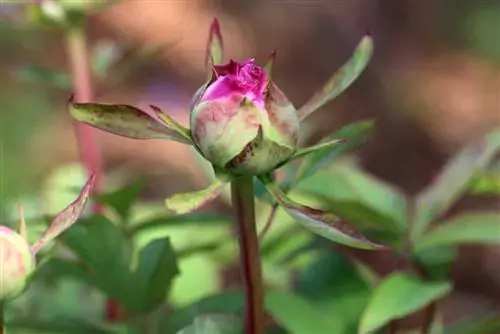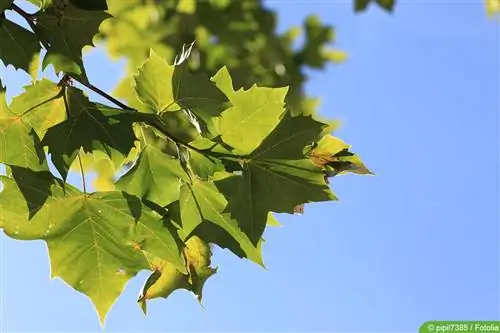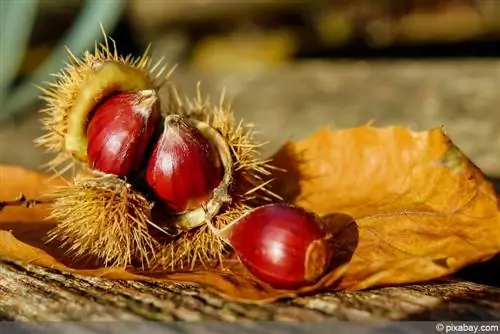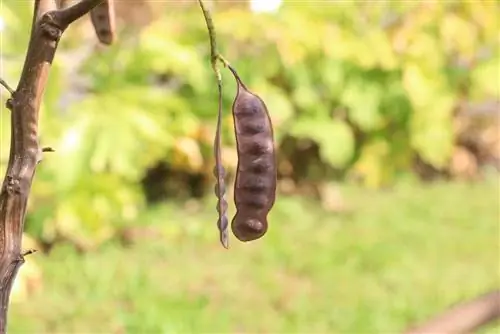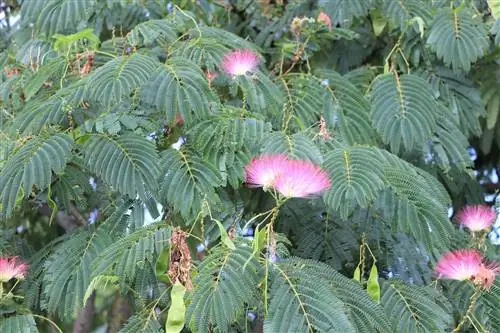- Author admin [email protected].
- Public 2023-12-17 03:39.
- Last modified 2025-01-24 12:45.
The shrub or tree peony grows like a bush with heights of 150 to 200 cm. However, it can take several years until it grows into a stately bush. As a striking solitary plant, it attracts everyone's attention with its attractive flowers. They impress with all imaginable colors, can be single or multi-colored, simple or filled and exude a very pleasant scent.
Profile
- Plant family: Peony family (Paeoniaceae)
- Botanical name: Paeonia suffruticosa
- German name: Shrub peony, tree peony
- Growth: shrub-like, woody, perennial
- Growth height: 150-200 cm
- Flower: large, ruffled or ruffled petals, white, yellow, pink, red, orange
- Flowering time: April/May to June
- Leaves: green, pinnate, lobed leaf margin
- Toxicity: slightly toxic to humans, highly toxic to pets
- Lime compatibility: Lime tolerant
Location
Tree peonies thrive best in sunny locations, but also tolerate light shade. However, the abundance of flowers decreases the darker the location. Shrub peonies find it difficult to assert themselves against strong root competition from other plants. You should therefore avoid being in the immediate vicinity of such plants or ensure that there is sufficient distance. A tree peony takes up an area of around two square meters. The longer it stands in one place, the more luxuriantly and magnificently it blooms. Consequently, it is important to choose the location carefully.
Floor
The soil should above all be permeable and deep. Loamy, humus-rich and nutrient-rich garden soils that can retain moisture well, especially in dry times, are well suited. However, they should not be waterlogged. Heavy soils can be made more permeable with sand or gravel. Or you can plant slightly elevated so that excess water can drain away easily. If it is more sandy, mix in some compost or clay. A layer of mulch made from dry leaves can also be helpful. Planting
Best time to plant
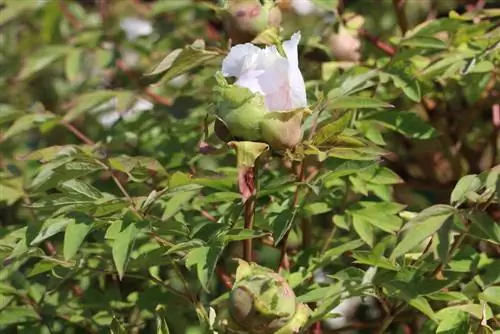
The correct planting time depends on the root packaging. Container specimens can be planted between March and November as long as the soil is frost-free. The months of August and September are optimal for bare-root peonies. For bare-root plants, soil and fine roots were removed. So that they can form fine roots again, planting should be completed at the end of September. Planting later can lead to stunted growth and, in the case of very young specimens, even total loss. They grow in properly after three to five years. From then on they reach full bloom.
Planting instructions
- Choose a cloudy day to plant
- First, water the root ball thoroughly
- In the meantime, dig a sufficiently large planting hole
- At least twice as wide and deep as the bale
- Mix excavated earth with rotted humus
- Loose up the soil in the planting hole and fill in some soil
- Mix in some horn shavings as starting fertilizer
- Insert peony slightly at an angle
- Promotes increased formation of main shoots and bushier growth
- Fill planting pit with excavated soil
- Cover root base 3-4 cm with soil
- Place the processing center for refined specimens deep enough
- Planting distances from other plants approx. 200 cm
- After planting, cut back above-ground branches except for a few eyes
- Water tree peony thoroughly
Tip:
As a planting partner, you should prefer species that emphasize the beauty of the tree peony and do not compete with it.
Transplanting
Tree peonies want to be in one and the same place permanently. If it is still necessary to transplant them, you should do so between August and September. In spring or early summer the young shoots could easily break off. In addition, the plants have a harder time rooting.
- Pick off roots widely
- Then carefully lift it out of the ground
- Preparing a new planting site
- Plant tree peony much deeper than herbaceous peony
- Place the grafting point 10-15 cm deep in the ground
- Be sure to plant scions
- Finally, water thoroughly
Most tree peonies are grafted onto perennial peonies. So that the scion of the tree peony can later detach itself from the base, it must form its own roots.
Tip:
It can take up to two years for peonies to recover from the shock of transplanting, during which they will have little or no flowering.
Do not transplant indiscriminately
When transplanting, it is important not to plant where there were already peonies. You should take a planting break of around ten years. The reason for this is the so-called soil fatigue, which leads to stunted growth and stunted growth. Replacing the soil only makes sense if the whole thing is done over a large area and, above all, deeply, because the roots of the shrub peony reach deep into the earth. The purpose of the replacement is to prevent rotting root residues from the previous plant from remaining in the soil. They would harbor a high potential for disease.
Care
Tree peonies can live up to 60 years under optimal conditions. Once established, they defy adversities such as summer drought. As they get older, they become woody and are therefore well protected from frosty temperatures. But they are also undemanding and easy to care for, as long as you pay attention to a few basic things, especially when watering and fertilizing.
Pouring
The water requirements of this attractive plant are rather low. Freshly planted specimens need to be watered regularly in the first two years after planting. Later, watering is limited to longer dry periods. Since the roots get water from deeper layers of the soil, they do not dry out as quickly. In addition, the frequency of watering depends on the water holding capacity or storage capacity of the soil.
Fertilize
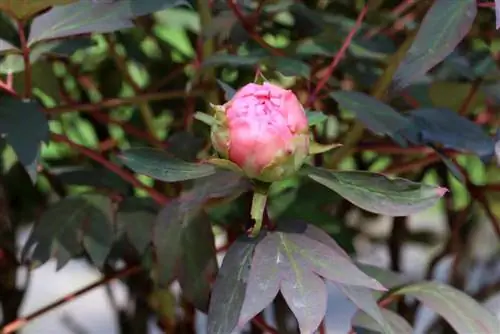
The need for nutrients is also comparatively low. You should fertilize from the second year at the earliest. Potash-phosphorus fertilization in late summer is recommended. It promotes the maturation of the wood and the formation of flowers. When choosing fertilizer, make sure that it does not contain too much nitrogen. Otherwise, fertilizing twice a year is completely sufficient, the first time in spring shortly before budding and the second time immediately after flowering. It is advisable to fertilize organically, for example with well-rotted compost. The tree peony reacts sensitively to fresh manure or artificial fertilizer.
Cutting
- Cutting is usually not necessary, but sometimes useful
- Recommended if growth is too sprawling
- Light pruning immediately after flowering
- Remove dead, disturbing and too close shoots
- Always cut above a bud that has not yet opened
- Cut off wilted flowers to prevent seed formation
- Rejuvenate older peonies if necessary
- To do this, shorten all shoots to 30-40 cm
Pruning before flowering is not recommended. Then it is very likely that you will have to remove the buds for the coming year and then have to forego the flowering. Cutting after mid-October is also unfavorable. The cuts can no longer heal until the first frost. The result is frost damage.
Wintering
In the year of planting or before the first winter, it is advisable to cover the root area of the tree peony with brushwood or dry leaves. Even if it is considered to be well hardy, the fresh shoots that appear from around February are at risk of late frost, as are the first buds in March. To protect the above-ground shoots from snow breakage, they can be tied together. If there is a risk of frost again in early spring, it makes sense to wrap the peony with fleece. As soon as frost is no longer expected, the fleece must be removed again.
Propagate
There are different ways to propagate the shrub peony, we show how to do it:
Sowing
If you want to use seeds from existing plants, it's a bit tricky because they should be slightly immature but not too immature either. To be on the safe side, it's best to harvest on different days.
- Stratify seeds immediately after harvesting
- Necessary to break dormancy
- Put seeds in a plastic bag with moist sand
- Store in the refrigerator at four to five degrees for about two months
- During this time, formation of fine radicles
- Then place the whole thing in a warmer place, around 20 degrees
- Continue to keep slightly moist
- Aboveground shoots with cotyledons can be seen in spring
- If not, repeat the process if necessary
- Seedlings then only in the second spring
Tip:
The flowers of young plants obtained by sowing usually do not have the same properties as the mother plant.
Cuttings
In late summer or autumn, cut off young, woody shoots that are 10-15 cm long. All but the top four to five leaves are removed, as are withered flowers. Now place the cuttings about three centimeters deep in small pots with moist potting soil. In the coming weeks, the substrate must be kept evenly moist so that rooting can occur. Once roots have formed, do not plant the cuttings directly outside, but leave them in the pots until a small ball has developed.
Division
Dividing tree peonies is only possible with refined specimens, if the plant in question itself was created through division or if it has already detached itself from the base and developed its own roots.
- To dig up, loosen the earth again over a large area
- Expose the balls as much as possible
- Carefully lift the plant out of the ground
- Do not pull out by the shoots
- Brittle roots could be damaged
- Remove loosely adhering soil as well as diseased and damaged root parts
- Divide the bale with a sharp knife or spade
Most of the time the bush falls apart on its own, so you win several pieces. They then just have to be planted at their destination and watered.
Tip:
In order to create the necessary balance between root volume and above-ground shoot volume, the latter is shortened by a little less than half.
Diseases

The tree peony is mainly susceptible to two diseases. We show you how to recognize them and combat them successfully.
Gray horse
The fungus that causes it finds optimal conditions in humus-rich soils and temperatures between 22 and 25 degrees. It causes brown, later rotting spots on leaves, flowers and stems. A mouse-gray, dusty coating forms. If there is an infestation, immediately cut out all affected parts down to the he althy tissue and dispose of them with household waste. If the infestation is already very advanced, the use of fungicides is often unavoidable.
Leaf spot disease
Signs of this disease include large, noticeable leaf spots that appear after the end of spring. They start from the edges and tips of the leaves, are light to purple-brown, enlarge and run into each other, and the leaves dry up. In damp weather, the spots on the undersides of the leaves are also covered with a velvety coating. To combat it, all affected parts of the plant must be removed and the cuttings disposed of in household waste. If this is not enough, fungicides may also have to be used.
Pests: Nematodes
Nematode infestation is relatively rare. Stunted growth, leaf discoloration, significantly fewer flowers and bulbous growths on the roots can indicate this. Unfortunately, affected plants usually cannot be saved. They must be dug up and completely disposed of.

